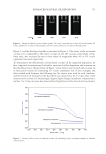723 PHYSICOCHEMICAL PROPERTIES OF TEXTURED HAIR for Caucasian (1.43–1.56) and African hair (1.67–2.01) (6). It is generally accepted that the extent of curvature of human hair along its length is associated with the shape of the fiber cross-section–cylindrical versus oval versus elliptical (42,43). One caveat to analyzing the cross-sectional shape of fibers in FESEM micrographs is the uncertainty of the hair fiber source. During the preparation procedure, the cross-sections need to be collected after each slice with the microtome to ensure that the number of measurements from each fiber is controlled. In any event, it is impossible to know the results of successive measurements on the same hair fiber using this procedure, unless, of course, cross-sections are obtained for a single fiber rather than a group of fibers. Using FESEM, we observed many important morphological features of hair cross-sections. Figure 10A provides a FESEM micrograph of Caucasian hair where the medulla region of hair can be clearly identified in the center of the fiber. The overall cross-section is elliptical in nature, and the medulla is porous. We do not always observe the medulla in Caucasian hair as it can sometimes be discontinuous along the length of the fiber (unlike Asian cross- sections, which almost always contain a medulla). Regardless, the medulla of Caucasian hair is often characterized by its porous nature, which is illustrated by the higher-magnification image in Figure 10B. Compared to Caucasian hair, sightings of the medulla are much less common in African hair. Figure 11 presents a FESEM micrograph of a cross-section of African hair. It appears that there is a medullary structure present close to the center of the fiber. Closer examination reveals a structure that is slightly discontinuous from the rest of the cortex. Studies have shown differences in medullary structure based on racial origin. For example, it was shown that the medulla index (ratio of medulla to overall hair fiber width) in ethnic Malays is smaller than that found in ethnic Chinese living in Malaysia (44). In a study of hair from indigenous Ghanaian individuals, it was found that the medulla could be absent, present, or discontinuous (45). The percentage occurrence of medulla for different anatomical regions decreased in the followed order: pubic, axilla, eyebrow, and scalp. From a slightly different perspective, the growth rate of African hair (256 μm/d±44) was reported as significantly slower than Caucasian hair (396 μm/d±55) (46,47). In a study of female scalp hair, it was previously reported that the medulla of white, nonpigmented hair was more developed than pigmented hair. Surprisingly, the growth rate of nonpigmented Figure 10. FESEM micrographs of a Caucasian hair fiber cross-section at magnifications of (A) ×1,800 and (B) ×10,000.
724 JOURNAL OF COSMETIC SCIENCE fibers (380 μm/d) was found to be greater than pigmented fibers (350 μm/d) (48). These data suggest a possible correlation between hair growth and medullary development. Furthermore, Asian hair (411 μm/d±53) has a faster growth rate than Caucasian or African hair and has the most developed medulla (43). Therefore, our data are in agreement with previous findings indicating that the slower growth rate of African hair leads to a more developed cortex (or less developed medulla) (49). It is also possible, but less likely, that the greater quantities of lipids (and other biological material) in the medulla of African hair make it appear less developed and porous. We made several interesting observations related to the microtome technique that was employed. As noted in the Materials and Methods section, a stainless-steel blade was used to cut the hair cross-sections in the microtome. Ideally, use of a diamond microtome blade is preferred, as this provides extremely smooth cuts. Unfortunately, this type of blade cannot be used with all cryotomes. Therefore, researchers are often restricted to the type of blade they can employ based on the available features of their microtome. Typically, stainless- steel blades dull after the first several slices of Caucasian hair. This is clearly illustrated in Figure 12A. We found that tightly curled African hair cross-sections rarely contain such a rough cut (Figure 12B). This could suggest some fundamental structural differences Figure 11. FESEM micrographs of an African hair fiber cross-section at magnifications of (A) ×1,100 and (B) ×8,000. Figure 12. FESEM micrographs of (A) Caucasian and (B) tightly curled African hair demonstrating the difference in surface roughness due to the use of a stainless-steel microtome blade.
Purchased for the exclusive use of nofirst nolast (unknown) From: SCC Media Library & Resource Center (library.scconline.org)






































































































































